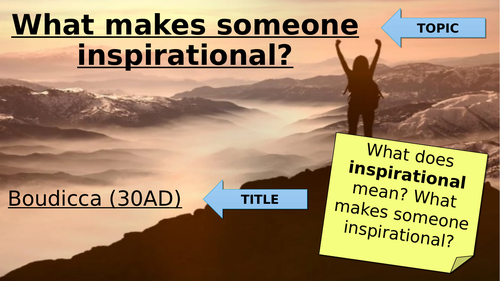


















Key Stage 3 History
Currently I am using this at the start of Year 8, but it would make a great project-based Scheme of Work for Year 7 as it would be a good transitional Unit into KS3. I have created every lesson so it is easily accessible and adaptable, and so that both specialist and non-specialist teachers of History can simply just pick it up and go. There is a full and detailed written Unit of Work to go along with the 10 lessons, as well a ‘Recall and Revise’ sheet that enables students to recall the previous lesson and to discuss the homework they have undertaken as a group as well. This document runs alongside the Unit, in the hope that it will help students when they get to the assessment.
Overall Question for the Scheme of Work is: “What Makes Someone Inspirational?” and in order to answer the question at the end of the Unit, students follow a set of 10 chronological lessons. They learn in class and at home about 10 inspirational people: Boudicca, William Wilberforce, Florence Nightingale, Winston Churchill, Albert Einstein, Helen Keller, Rosa Parks, Nelson Mandela, Martin Luther King and Malala Yousafzai. By the end of the Unit, students will have created a timeline that spans from Boudicca through to Malala Yousafzai and will have learnt about the incredible, inspirational lives of all 10 people, as well as the historical context in which these individuals lived and the circumstances that lead to them becoming inspirational.
Activities in lesson include: Round the Room fact hunt, video clips with accompanying questions, source analysis, group research, find someone who knows, empathy tasks, discussion work, as well as individual and group work.
The Learning Objectives for every lesson are based on Blooms Taxonomy and are tied into the new GCSE 9-1 grading system (as best I could!). They are also repeated throughout so that students and teachers know exactly what is expected every single lesson, and so that proving progress is straightforward and clear.
Something went wrong, please try again later.
This resource hasn't been reviewed yet
To ensure quality for our reviews, only customers who have purchased this resource can review it
Report this resourceto let us know if it violates our terms and conditions.
Our customer service team will review your report and will be in touch.
